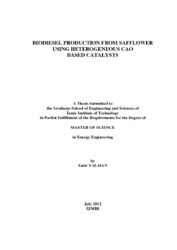Please use this identifier to cite or link to this item:
https://hdl.handle.net/11147/3483Full metadata record
| DC Field | Value | Language |
|---|---|---|
| dc.contributor.advisor | Şeker, Erol | en |
| dc.contributor.author | Yalman, Emir | - |
| dc.date.accessioned | 2014-07-22T13:51:38Z | - |
| dc.date.available | 2014-07-22T13:51:38Z | - |
| dc.date.issued | 2012 | en |
| dc.identifier.uri | http://hdl.handle.net/11147/3483 | - |
| dc.description | Thesis (Master)--Izmir Institute of Technology, Energy Engineering, Izmir, 2012 | en |
| dc.description | Includes bibliographical references (leaves: 35-39) | en |
| dc.description | Text in English; Abstract: Turkish and English | en |
| dc.description | viii, 39 leaves | en |
| dc.description.abstract | In this study, the activities of heterogeneous mixed oxide catalyst; calcium oxide on alumina was investigated in the transesterification of canola and safflower vegetable oils to produce biodiesel, i.e. methyl esters. The primary goal of this study is to understand the effect of calcination temperature and calcium oxide (CaO) loading on the conversion activity of calcium oxide on alumina in the transesterification of canola and safflower vegetable oils. The mixed oxide catalyst was prepared by a modified single step sol-gel method. Calcium oxide was chosen because of its well known basic property. This study shows that calcium oxide on alumina catalysts having high CaO dispersion, calcined at high temperature, gave high biodiesel yields even under the reaction conditions, such as low reaction temperature, 50 °C, 9 of methanol/Oil molar ratio, 6 wt. % of catalyst/oil, and also short biodiesel reaction time, such as 4 – 10 minutes in the transesterification of safflower and canola oils. Also, it was observed that 70% CaO/Al2O3 catalyst when calcined at 700 °C was the most active catalyst among all the catalysts prepared in this study. Moreover, the reusability of CaO/Al2O3 demonstrated that ~20 – 250 ppm of Ca was lost during the reaction and the amount of Ca cation leaching depended on the reaction time, CaO loading and the calcination temperature. Also, it was found that Ca cation loss occurred during the reaction did not hinder the activity of the catalysts, which was found by the reusing the catalysts for couple times. Besides, when the biodiesel yield was higher than 70%, the system was influenced by external mass transfer limitation. | en |
| dc.language.iso | en | en_US |
| dc.publisher | Izmir Institute of Technology | en |
| dc.rights | info:eu-repo/semantics/openAccess | en_US |
| dc.subject.lcsh | Biodiesel fuels | en |
| dc.subject.lcsh | Vegetable oils as fuel | en |
| dc.subject.lcsh | Safflower | en |
| dc.subject.lcsh | Canola oil | en |
| dc.subject.lcsh | Catalysts | en |
| dc.subject.lcsh | Lime | en |
| dc.subject.lcsh | Heterogeneous catalysis | en |
| dc.title | Biodiesel production from safflower using heterogeneous cao based catalysts | en_US |
| dc.type | Master Thesis | en_US |
| dc.institutionauthor | Yalman, Emir | - |
| dc.department | Thesis (Master)--İzmir Institute of Technology, Energy Systems Engineering | en_US |
| dc.relation.publicationcategory | Tez | en_US |
| item.languageiso639-1 | en | - |
| item.fulltext | With Fulltext | - |
| item.openairecristype | http://purl.org/coar/resource_type/c_18cf | - |
| item.openairetype | Master Thesis | - |
| item.grantfulltext | open | - |
| item.cerifentitytype | Publications | - |
| Appears in Collections: | Master Degree / Yüksek Lisans Tezleri | |
Files in This Item:
| File | Description | Size | Format | |
|---|---|---|---|---|
| T001022.pdf | MasterThesis | 1.23 MB | Adobe PDF |  View/Open |
CORE Recommender
Page view(s)
160
checked on Jul 22, 2024
Download(s)
98
checked on Jul 22, 2024
Google ScholarTM
Check
Items in GCRIS Repository are protected by copyright, with all rights reserved, unless otherwise indicated.